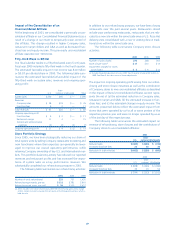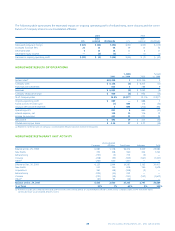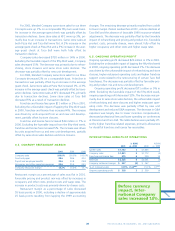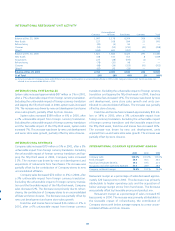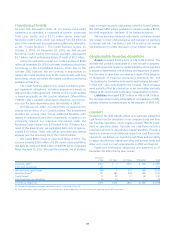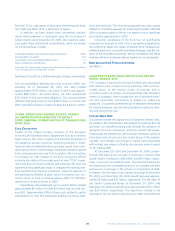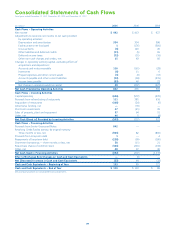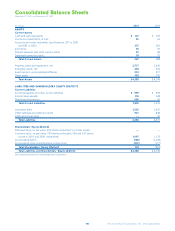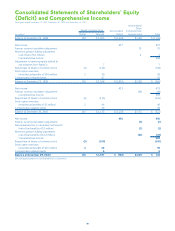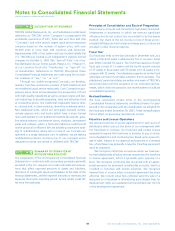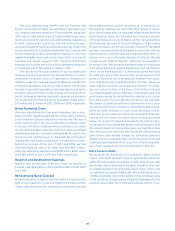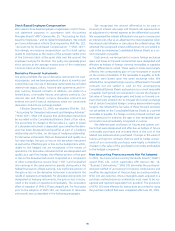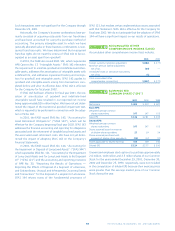Pizza Hut 2001 Annual Report Download - page 39
Download and view the complete annual report
Please find page 39 of the 2001 Pizza Hut annual report below. You can navigate through the pages in the report by either clicking on the pages listed below, or by using the keyword search tool below to find specific information within the annual report.37
primarily due to the additional Senior Unsecured Notes issued
in 2001. Fair value was determined by discounting the projected
cash flows.
Foreign Currency Exchange Rate Risk
International ongoing operating profit constituted approximately
31% and 29% of our 2001 and 2000 ongoing operating profit,
respectively, excluding unallocated and corporate expenses and
foreign exchange net loss. In addition, the Company’s net asset
exposure (defined as foreign currency assets less foreign cur-
rency liabilities) totaled approximately $1 billion and $900 million
as of December 29, 2001 and December 30, 2000, respectively.
Operating in international markets exposes the Company to
movements in foreign currency exchange rates. The Company’s
primary exposures result from our operations in Asia-Pacific and
Europe. Changes in foreign currency exchange rates would
impact the translation of our investments in foreign operations,
the fair value of our foreign currency denominated financial
instruments and our reported foreign currency denominated
earnings and cash flows.
We attempt to minimize the exposure related to our invest-
ments in foreign operations by financing those investments with
local currency debt when practical. In addition, we attempt to
minimize the exposure related to foreign currency denominated
financial instruments by purchasing goods and services from third
parties in local currencies when practical. Consequently, foreign
currency denominated financial instruments consist primarily of
intercompany short-term receivables and payables. At times, we
utilize forward contracts to reduce our risk exposure related to
these foreign currency denominated financial instruments. The
notional amount and maturity dates of these contracts match
those of the underlying receivables or payables such that our
foreign currency exchange risk related to these instruments is
eliminated. On a limited basis, we utilize forward contracts in
order to reduce our risk exposure related to certain foreign cur-
rency denominated cash flows from royalties. There were no
such forward contracts outstanding as of December 29, 2001.
Commodity Price Risk
We are subject to volatility in food costs as a result of market
risk associated with commodity prices. Our ability to recover
increased costs through higher pricing is, at times, limited by the
competitive environment in which we operate. We manage our
exposure to this risk primarily through pricing agreements as
well as, on a limited basis, commodity future and option con-
tracts. There were no commodity future and option contracts
outstanding at December 29, 2001, and those outstanding at
December 30, 2000, were not significant to the Consolidated
Financial Statements.
CAUTIONARY STATEMENTS
From time to time, in both written reports and oral statements,
we present “forward-looking statements” within the meaning
of Section 27A of the Securities Act of 1933, as amended, and
Section 21E of the Securities Exchange Act of 1934, as
amended. The statements include those identified by such
words as “may,” “will,” “expect,” “anticipate,” “believe,”
“plan” and other similar terminology. These “forward-looking
statements” reflect our current expectations regarding future
events and operating and financial performance and are based
upon data available at the time of the statements. Actual results
involve risks and uncertainties, including both those specific to
the Company and those specific to the industry, and could dif-
fer materially from expectations.
Company risks and uncertainties include, but are not lim-
ited to, potentially substantial tax contingencies related to the
Spin-off, which, if they occur, require us to indemnify PepsiCo,
Inc.; our substantial debt leverage and the attendant potential
restriction on our ability to borrow in the future, as well as our
substantial interest expense and principal repayment obligations;
our ability to replace or refinance the Credit Facilities at reason-
able rates; potential unfavorable variances between estimated
and actual liabilities including the liabilities related to the sale of
the non-core businesses; our ability to secure alternative distri-
bution of products and equipment to our restaurants and our
ability to ensure adequate supply of restaurant products and
equipment in our stores; our ability to complete our Euro con-
version plans or the ability of our key suppliers to be
Euro-compliant; the ongoing financial viability of our franchisees
and licensees; volatility of actuarially determined losses and loss
estimates and adoption of new or changes in accounting poli-
cies and practices including pronouncements promulgated by
standard setting bodies.
Industry risks and uncertainties include, but are not limited
to, global and local business, economic and political conditions;
legislation and governmental regulation; competitor activities;
success of operating initiatives and advertising and promotional
efforts; volatility of commodity costs; increases in minimum
wage and other operating costs; availability and cost of land and
construction; consumer preferences, spending patterns and
demographic trends; political or economic instability in local
markets and changes in currency exchange and interest rates.


